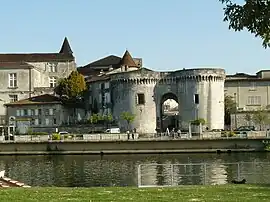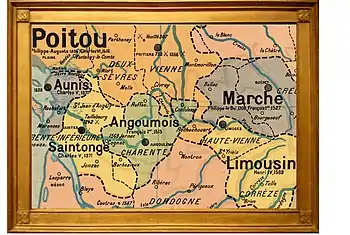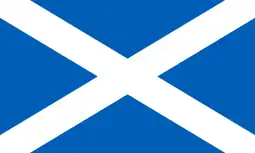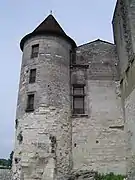Cognac, France
Cognac (French pronunciation: [kɔɲak] ⓘ; Saintongese: Cougnat; Occitan: Conhac [kuˈɲak] ⓘ) is a commune in the Charente department, southwestern France. Administratively, the commune of Cognac is a subprefecture of the Charente department.
Cognac | |
|---|---|
Subprefecture and commune | |
 The Saint-Jacques gate in Cognac | |
.svg.png.webp) Coat of arms | |
Location of Cognac | |
 Cognac  Cognac | |
| Coordinates: 45°42′N 0°20′W | |
| Country | France |
| Region | Nouvelle-Aquitaine |
| Department | Charente |
| Arrondissement | Cognac |
| Canton | Cognac-1 and 2 |
| Intercommunality | CA Grand Cognac |
| Government | |
| • Mayor (2020–2026) | Morgan Berger[1] |
| Area 1 | 15.5 km2 (6.0 sq mi) |
| Population | 18,606 |
| • Density | 1,200/km2 (3,100/sq mi) |
| Time zone | UTC+01:00 (CET) |
| • Summer (DST) | UTC+02:00 (CEST) |
| INSEE/Postal code | 16102 /16100 |
| Elevation | 5–53 m (16–174 ft) (avg. 27 m or 89 ft) |
| 1 French Land Register data, which excludes lakes, ponds, glaciers > 1 km2 (0.386 sq mi or 247 acres) and river estuaries. | |
Name
The name is believed to be formed from individual masculine name -Connius, Gallic name, and the suffix -acum, which would correspond to the "domain of Connius".
History
The town of Cognac was unknown before the ninth century, when it was fortified. During the Hundred Years' War, the town continually changed sides, according to the tides of war. In 1526, it lent its name to the War of the League of Cognac, the military alliance established by King Francis I of France to fight against the House of Habsburg. As a benefit of the War League of Cognac, King Francis I granted to the town of Cognac the commercial right to participate in the salt trade conducted along the river, from which regional Cognac developed into a centre for the production of wine and brandy.[3]
In November 1651, Cognac was besieged by rebels led by Prince de Condé during the 1648-1653 civil war, the "Fronde"; and the town was relieved in December by a force under Comte d'Harcourt; afterwards, King Louis XIV granted Cognac additional commercial rights.[4]

Cognac was part of the historic French province of Angoumois. In 1790, following the French Revolution that began the year before, the provinces were abolished and Angoumois became part of the newly created department of Charente.
Geography
Cognac is situated on the river Charente between the towns of Angoulême and Saintes. The majority of the town has been built on the river's left bank, with the smaller right bank area known as the Saint Jacques district. The town is situated on one of the pilgrimage routes to Santiago de Compostela and is home to the French Air Force training base 709. Cognac is 400 kilometers (250 mi) southwest of Paris.
Cognac brandy
The town gives its name to one of the world's best-known types of brandy or eau de vie. Drinks must be made in certain areas around the town of Cognac and must be made according to strictly defined regulations to be granted the name Cognac.
Cognac is a unique spirit in that it is double-distilled. This process can be viewed in one of the many "Grande Marque" Cognac houses which all have visitor centres. Most central in the town are Hennessy, Martell, Otard, Camus and Remy Martin. About 15 km (9 mi) east of Cognac is Jarnac, home to Courvoisier.
There are six vineyard areas around the Cognac area, all of which are within the Appellation Controlee for Cognac, but which are considered to vary in quality from the best growth area of "Grande Champagne" (nothing to do with the Champagne wine region in NE France), through "Petite Champagne" then "Borderies", "Fins Bois", "Bon Bois" and finally "Bois Ordinaire". All Cognac is produced by blending a variety of eau de vie which can be made from grapes from different locations, and from different vintages. It is the cellar master's skill that ensures that a brand's Cognac is recognizable regardless of when it is produced, since he can blend multiple eaux de vie to achieve the right taste for his house.
Different qualities of Cognac are produced by all brands, and include VS ("Very Special"); VSOP ("Very Superior [or, more commonly, "Special", though the Bureau National Interprofessionnel du Cognac specifies "Superior"] Old Pale") and XO ("eXtra Old"). (English terms are still used, since in the early days of Cognac production it was the British who were the main consumers and also became some of the main producers of Cognac, using techniques acquired from the distillation of whisky, etc.) These are controlled by the length of time the Cognac is allowed to mature in oak barrels, a minimum time being required at each grade level. The longer the Cognac matures in the barrel the smoother it will generally become. Once it is bottled no further development takes place. Most houses still have barrels of Cognac dating back to the 19th century sitting in their cellars waiting for fine blending by the Cellar Master.
Climate
| Climate data for Cognac, France (1981–2010 averages) | |||||||||||||
|---|---|---|---|---|---|---|---|---|---|---|---|---|---|
| Month | Jan | Feb | Mar | Apr | May | Jun | Jul | Aug | Sep | Oct | Nov | Dec | Year |
| Record high °C (°F) | 18.4 (65.1) |
22.5 (72.5) |
26.2 (79.2) |
31.0 (87.8) |
34.0 (93.2) |
40.0 (104.0) |
40.3 (104.5) |
39.6 (103.3) |
36.4 (97.5) |
30.6 (87.1) |
24.7 (76.5) |
20.5 (68.9) |
40.1 (104.2) |
| Average high °C (°F) | 9.4 (48.9) |
11.0 (51.8) |
14.4 (57.9) |
16.9 (62.4) |
20.8 (69.4) |
24.3 (75.7) |
26.8 (80.2) |
26.7 (80.1) |
23.5 (74.3) |
18.9 (66.0) |
13.0 (55.4) |
9.8 (49.6) |
18.0 (64.4) |
| Average low °C (°F) | 2.8 (37.0) |
2.8 (37.0) |
4.9 (40.8) |
6.9 (44.4) |
10.6 (51.1) |
13.6 (56.5) |
15.3 (59.5) |
15.0 (59.0) |
12.3 (54.1) |
9.8 (49.6) |
5.5 (41.9) |
3.3 (37.9) |
8.6 (47.5) |
| Record low °C (°F) | −17.5 (0.5) |
−19.4 (−2.9) |
−10.2 (13.6) |
−2.9 (26.8) |
−0.2 (31.6) |
3.0 (37.4) |
6.4 (43.5) |
5.5 (41.9) |
2.2 (36.0) |
−3.8 (25.2) |
−8.4 (16.9) |
−14.5 (5.9) |
−19.4 (−2.9) |
| Average precipitation mm (inches) | 71.9 (2.83) |
52.0 (2.05) |
57.7 (2.27) |
71.0 (2.80) |
65.1 (2.56) |
52.3 (2.06) |
48.2 (1.90) |
47.3 (1.86) |
59.8 (2.35) |
81.2 (3.20) |
86.3 (3.40) |
84.3 (3.32) |
777.1 (30.59) |
| Average precipitation days | 11.7 | 9.2 | 10.1 | 11.3 | 10.7 | 7.5 | 7.0 | 6.6 | 8.0 | 11.4 | 11.7 | 11.9 | 117.0 |
| Average relative humidity (%) | 87 | 82 | 76 | 74 | 75 | 72 | 69 | 72 | 76 | 83 | 87 | 88 | 78 |
| Mean monthly sunshine hours | 83.0 | 111.9 | 162.4 | 180.5 | 215.9 | 238.4 | 249.9 | 244.8 | 199.2 | 137.3 | 91.2 | 81.4 | 1,995.9 |
| Source 1: Meteo France[5][6] | |||||||||||||
| Source 2: Infoclimat.fr (humidity, 1961–1990)[7] | |||||||||||||
Population
The inhabitants of the town are known in French as Cognaçais.[8]
|
| |||||||||||||||||||||||||||||||||||||||||||||||||||||||||||||||||||||||||||||||||||||||||||||||||||||||||||||||
| Source: EHESS[9] and INSEE (1968-2017)[10] | ||||||||||||||||||||||||||||||||||||||||||||||||||||||||||||||||||||||||||||||||||||||||||||||||||||||||||||||||
Landmarks
- The Old Town. The town's medieval quarter "Vieux Cognac" runs from the Tours Saint-Jacques, alongside the river, up to the Saint-Léger church. The area contains many unusual buildings, built between the 15th and 18th centuries, situated on narrow cobbled streets. Many contain sculptures of the salamander, the symbol of King François I, as well as gargoyles and richly decorated façades.
- The Château des Valois, an important medieval trading post.
- The Saint-Léger church. Church Exterior[11][12]
- The musée d'Art et d'Histoire (art and history museum)
- The musée des arts du Cognac (art museum)
- The Saint-Gobain glassworks and barrelworks
- Cognac Public Garden
Notable people
- The botanist Pierre Boiteau (1911–1980) was born in Cognac
- The glassmaker Claude Boucher, inventor of the glass-blowing machine in around 1880, lived and worked in Cognac
- The car manufacturer Louis Delâge was born in Cognac in 1874
- Francis I (king of France between 1515 and 1547) was born in the town's castle in 1494. The town's main square is named after him and a statue of the king, on horseback over his enemies, stands at the centre.
- Paul-Emile Lecoq de Boisbaudran, born in Cognac in 1838, discovered the elements Gallium in 1875 and Samarium in 1878
- Jean Monnet, one of the founding fathers of the European Union, was born in Cognac in 1888 and ran the Monnet Cognac family-controlled enterprise in the 1920s
- The French adult film star and model François Sagat was born in Cognac.
- The French poet Octavien de Saint-Gelais was born in Cognac in 1468
Sport
- US Cognac is the city's rugby union team.
- Cognac was the start of Stage 19 in the 2007 Tour de France.
Twin towns—sister cities
 Boala, Burkina Faso
Boala, Burkina Faso Bozhou, China
Bozhou, China Denison, United States
Denison, United States Königswinter, Germany
Königswinter, Germany Michalovce, Slovakia
Michalovce, Slovakia Perth, Scotland
Perth, Scotland Pisco, Peru
Pisco, Peru Tovuz, Azerbaijan
Tovuz, Azerbaijan Valdepeñas, Spain
Valdepeñas, Spain Vyškov, Czech Republic
Vyškov, Czech Republic
Gallery
.JPG.webp) The Musée des arts du Cognac
The Musée des arts du Cognac The Château des Valois
The Château des Valois The Château des Valois
The Château des Valois
See also
- The Coniacian Age of the Cretaceous Period of geological time is named for the city of Cognac
- Communes of the Charente department
References
- "Répertoire national des élus: les maires". data.gouv.fr, Plateforme ouverte des données publiques françaises (in French). 2 December 2020.
- "Populations légales 2020". The National Institute of Statistics and Economic Studies. 29 December 2022.
- Rikard, J. "Second Hapsburg-Valois War or War of the League of Cognac (1526-30)". History of War. Retrieved 30 January 2019.
- Kenny, Peter Francis (2016). Heroes, Villains, and Conflicts. Xlibris. ISBN 978-1514443781. Retrieved 30 January 2019.
- "Données climatiques de la station de Cognac" (in French). Meteo France. Retrieved 14 January 2016.
- "Climat Poitou-Charentes" (in French). Meteo France. Archived from the original on 1 December 2018. Retrieved 14 January 2016.
- "Normes et records 1961-1990: Cognac-Châteaubernard (16) - altitude 30m" (in French). Infoclimat. Retrieved 14 January 2016.
- Charente, habitants.fr
- Des villages de Cassini aux communes d'aujourd'hui: Commune data sheet Cognac, EHESS (in French).
- Population en historique depuis 1968, INSEE
- "Archived copy". Archived from the original on 20 April 2007. Retrieved 12 May 2007.
{{cite web}}: CS1 maint: archived copy as title (link) - Archived November 23, 2006, at the Wayback Machine
- "Les jumelages". ville-cognac.fr (in French). Cognac. Retrieved 13 November 2019.